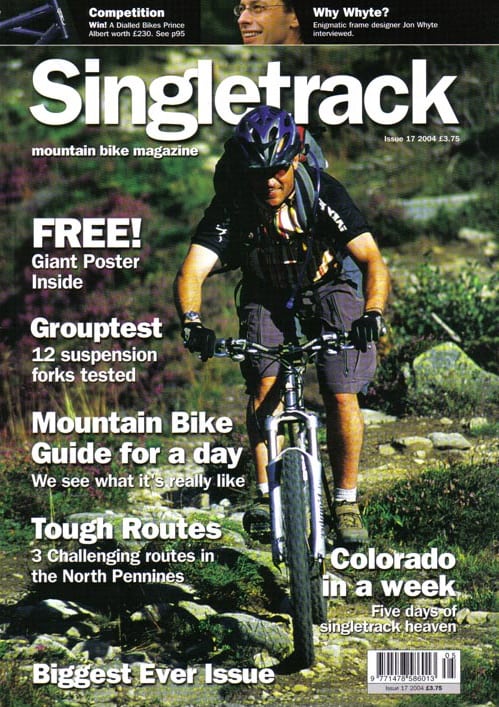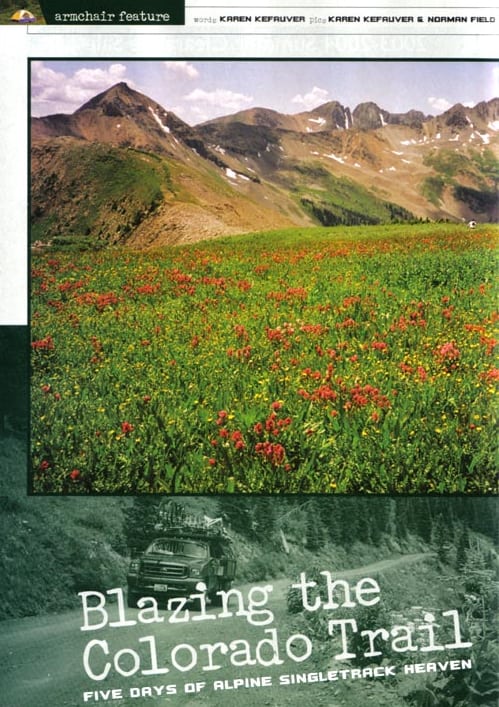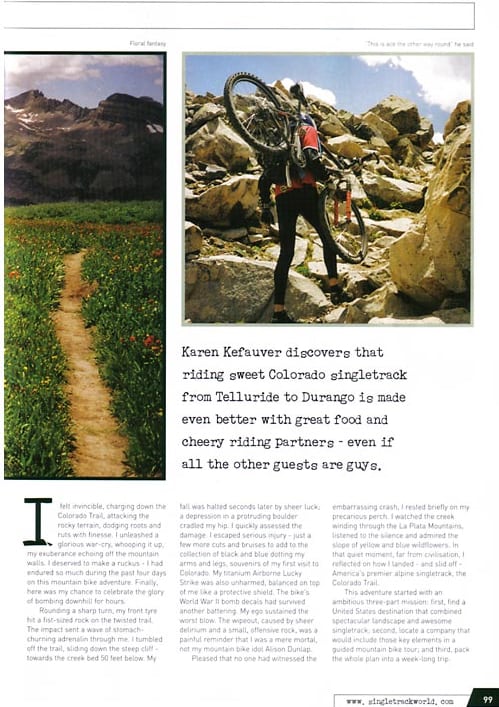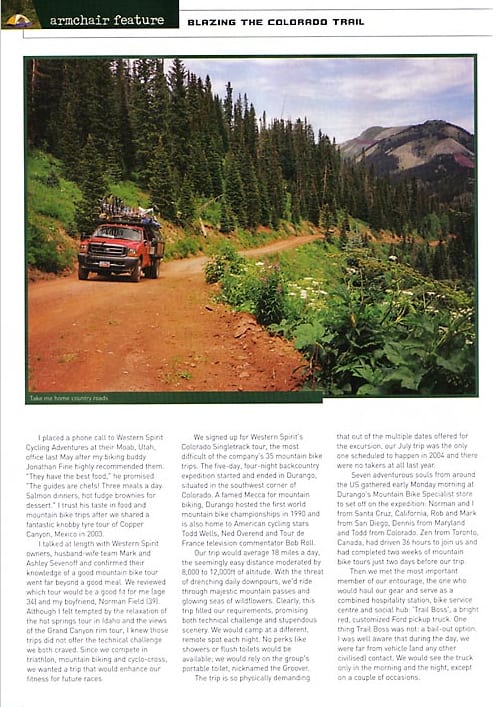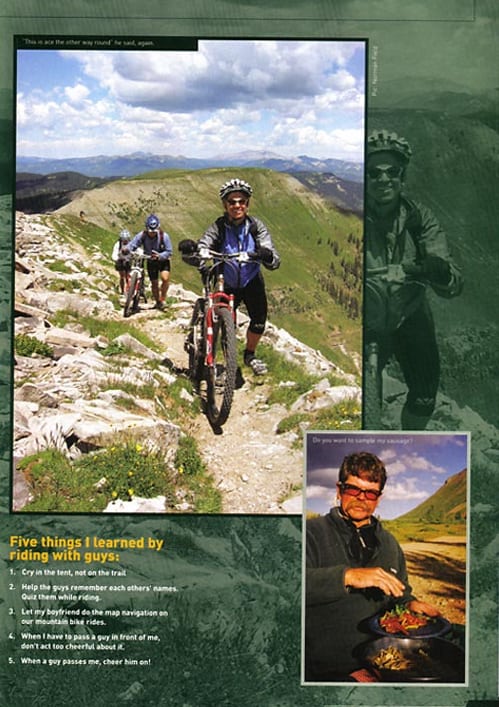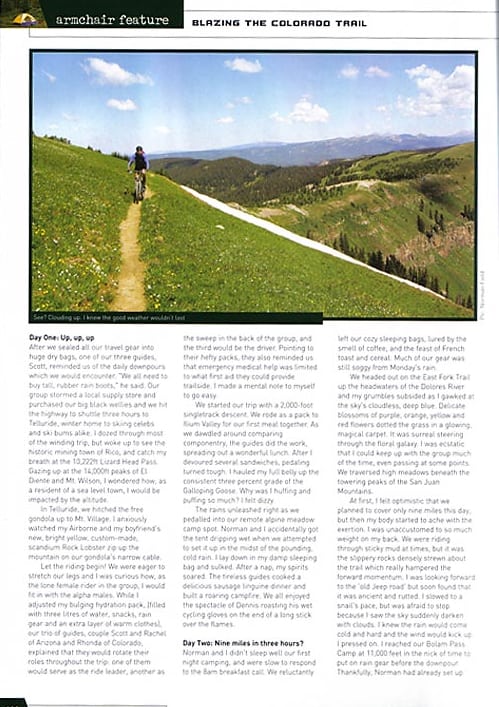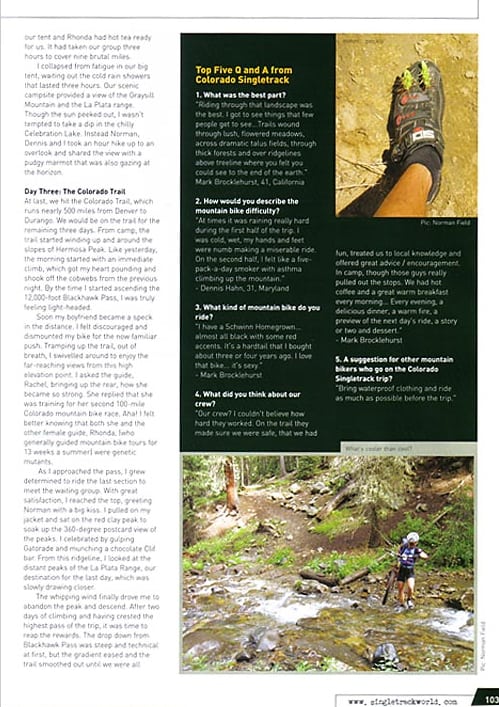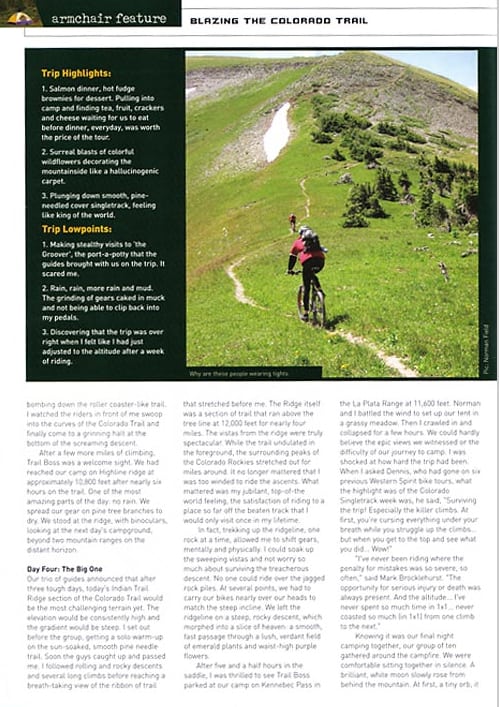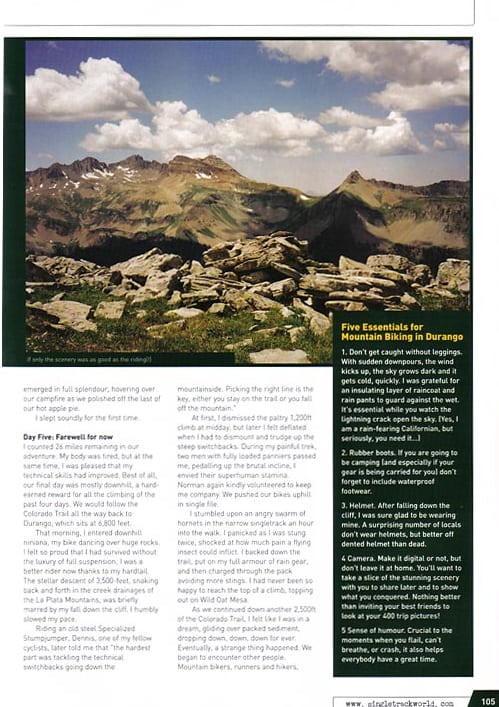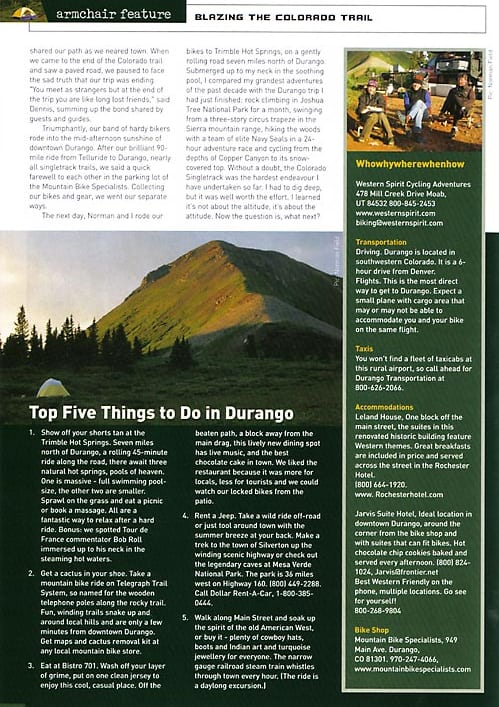Five days of alpine singletrack heaven
Issue 17, 2004
Singletrack Magazine
By Karen Kefauver (Photos by: Karen Kefauver and Norman Field)
Karen Kefauver discovers that riding sweet Colorado singletrack from Telluride to Durango is made even better with great food and cheery riding partners – even if all the other guests are guys.
I felt invincible, charging down the Colorado Trail, attacking the rocky terrain, dodging roots and ruts with finesse. I unleashed a glorious war-cry, whooping it up, my exuberance echoing off the mountain walls. I deserved to make a ruckus – I had endured so much during the past four days on this mountain bike adventure. Finally, here was my chance to celebrate the glory of bombing downhill for hours.
Rounding a sharp turn, my front tire hit a fist-sized rock on the twisted trail. The impact sent a wave of stomach-churning adrenalin through me. I tumbled off the trail, sliding down the steep cliff – towards the creek bed 50 feet below. My fall was halted seconds later by sheer luck: a depression in a protruding boulder cradled my hip. I quickly assessed the damage. I escaped serious injury – just a few more cuts and bruises to add to the collection of black and blue dotting my arms and legs, souvenirs of my first visit to Colorado. My titanium Airborne Lucky Strike was also unharmed, balanced on top of me like a protective shield. The bike’s World War II bomb decals had survived another battering. My ego sustained the worst blow. The wipeout, caused by sheer delirium and a small, offensive rock, was a painful reminder that I was a mere mortal, not my mountain bike idol Alison Dunlap. Pleased that no one had witnessed the embarrassing crash, I rested briefly on my precarious perch. I watched the creek winding through the La Plata Mountains, listened to the silence and admired the slope of yellow and blue wildflowers. In that quiet moment, far from civilisation, I reflected on how I landed – and slid off -America’s premier alpine singletrack, the Colorado Trail.
This adventure started with an ambitious three-part mission: first, find a United States destination that combined spectacular landscape and awesome singletrack; second, locate a company that would include those key elements in a guided mountain bike tour; and third, pack the whole plan into a week-long trip.
I placed a phone call to Western Spirit Cycling Adventures at their Moab, Utah, office last May after my biking buddy Jonathan Fine highly recommended them: “They have the best food,” he promised. “The guides are chefs! Three meals a day. Salmon dinners, hot fudge brownies for dessert.” I trusted his taste in food and mountain bike trips after we shared a fantastic knobby tyre tour of Copper Canyon, Mexico in 2003.
I talked at length with Western Spirit owners, husband-wife team Mark and Ashley Sevenoff and confirmed their knowledge of a good mountain bike tour went far beyond a good meal. We reviewed which tour would be a good fit for me (age 34) and my boyfriend, Norman Field, 39. Although I felt tempted by the relaxation of the hot springs tour in Idaho and the views of the Grand Canyon rim tour, I knew those trips did not offer the technical challenge we both craved. Since we compete in triathlon, mountain biking and cyclo-cross, we wanted a trip that would enhance our fitness for future races.
We signed up for Western Spirit’s Colorado Singletrack tour, the most difficult of the company’s 35 mountain bike trips. The five-day, four-night backcountry expedition started and ended in Durango, situated in the southwest corner of Colorado. A famed Mecca for mountain biking, Durango hosted the first world mountain bike championships in 1990 and is also home to American cycling stars Todd Wells, Ned Overend and Tour de France television commentator Bob Roll.
Our trip would average 18 miles a day, the seemingly easy distance moderated by 8,000 to 12,000ft of altitude. With the threat of drenching daily downpours, we’d ride through majestic mountain passes and glowing seas of wildflowers. Clearly, this trip filled our requirements, promising both technical challenge and stupendous scenery. We would camp at a different, remote spot each night. No perks like showers or flush toilets would be available; we would rely on the group’s portable toilet, nicknamed the Groover.
The trip is so physically demanding that out of the multiple dates offered for the excursion, our July trip was the only one scheduled to happen in 2004 and there were no takers at all last year.
Seven adventurous souls from around the US gathered early Monday morning at Durango’s Mountain Bike Specialist store to set off on the expedition: Norman and I from Santa Cruz, California, Rob and Mark from San Diego, Dennis from Maryland and Todd from Colorado. Zen from Toronto, Canada, had driven 36 hours to join us and had completed two weeks of mountain bike tours just two days before our trip.
Then we met the most important member of our entourage, the one who would haul our gear and serve as a combined hospitality station, bike service centre and social hub: ‘Trail Boss’, a bright red, customized Ford pickup truck. One thing Trail Boss was not: a bail-out option. I was well aware that during the day, we were far from vehicle (and any other civilised) contact. We would see the truck only in the morning and the night, except on a couple of occasions.
Day One: Up, up, up
After we sealed all our travel gear into huge dry bags, one of our three guides, Scott, reminded us of the daily downpours which we would encounter. “We all need to buy tall, rubber rain boots,” he said. Our group stormed a local supply store and purchased our big black wellies and we hit the highway to shuttle three hours to Telluride, winter home to skiing celebs and ski bums alike. I dozed through most of the winding trip, but woke up to see the historic mining town of Rico, and catch my breath at the 10,222ft Lizard Head Pass. Gazing up at the 14,000ft peaks of El Diente and Mt. Wilson, I wondered how, as a resident of a sea level town, I would be impacted by the altitude.
In Telluride, we hitched the free gondola up to Mt. Village. I anxiously watched my Airborne and my boyfriend’s new, bright yellow, custom-made, scandium Rock Lobster zip up the mountain on our gondola’s narrow cable.
Let the riding begin! We were eager to stretch our legs and I was curious how, as the lone female rider in the group, I would fit in with the alpha males. While I adjusted my bulging hydration pack, (filled with three litres of water, snacks, rain gear and an extra layer of warm clothes), our trio of guides, couple Scott and Rachel of Arizona and Rhonda of Colorado, explained that they would rotate their roles throughout the trip: one of them would serve as the ride leader, another as the sweep in the back of the group, and the third would be the driver. Pointing to their hefty packs, they also reminded us that emergency medical help was limited to what first aid they could provide trailside. I made a mental note to myself to go easy.
We started our trip with a 2,000-foot singletrack descent. We rode as a pack to Ilium Valley for our first meal together. As we dawdled around comparing componentry, the guides did the work, spreading out a wonderful lunch. After I devoured several sandwiches, pedaling turned tough. I hauled my full belly up the consistent three percent grade of the Galloping Goose. Why was I huffing and puffing so much? I felt dizzy.
The rains unleashed right as we pedalled into our remote alpine meadow camp spot. Norman and I accidentally got the tent dripping wet when we attempted to set it up in the midst of the pounding, cold rain. I lay down in my damp sleeping bag and sulked. After a nap, my spirits soared. The tireless guides cooked a delicious sausage linguine dinner and built a roaring campfire. We all enjoyed the spectacle of Dennis roasting his wet cycling gloves on the end of a long stick over the flames.
Day Two: Nine miles in three hours?
Norman and I didn’t sleep well our first night camping, and were slow to respond to the 8am breakfast call. We reluctantly left our cozy sleeping bags, lured by the smell of coffee, and the feast of French toast and cereal. Much of our gear was still soggy from Monday’s rain.
We headed out the East Fork Trail up the headwaters of the Dolores River and my grumbles subsided as I gawked at the sky’s cloudless, deep blue. Delicate blossoms of purple, orange, yellow and red flowers dotted the grass in a glowing, magical carpet. It was surreal steering through the floral galaxy. I was ecstatic that I could keep up with the group much of the time, even passing at some points. We traversed high meadows beneath the towering peaks of the San Juan Mountains.
At first, I felt optimistic that we planned to cover only nine miles this day, but then my body started to ache with the exertion. I was unaccustomed to so much weight on my back. We were riding through sticky mud at times, but it was the slippery rocks densely strewn about the trail which really hampered the forward momentum. I was looking forward to the ‘old Jeep road’ but soon found that it was ancient and rutted. I slowed to a snail’s pace, but was afraid to stop because I saw the sky suddenly darken with clouds. I knew the rain would come cold and hard and the wind would kick up. I pressed on. I reached our Bolam Pass Camp at 11,000 feet in the nick of time to put on rain gear before the downpour. Thankfully, Norman had already set up our tent and Rhonda had hot tea ready for us. It had taken our group three hours to cover nine brutal miles.
I collapsed from fatigue in our big tent, waiting out the cold rain showers that lasted three hours. Our scenic campsite provided a view of the Graysill Mountain and the La Plata range. Though the sun peeked out, I wasn’t tempted to take a dip in the chilly Celebration Lake. Instead Norman, Dennis and I took an hour hike up to an overlook and shared the view with a pudgy marmot that was also gazing at the horizon.
Day Three: The Colorado Trail
At last, we hit the Colorado Trail, which runs nearly 500 miles from Denver to Durango. We would be on the trail for the remaining three days. From camp, the trail started winding up and around the slopes of Hermosa Peak. Like yesterday, the morning started with an immediate climb, which got my heart pounding and shook off the cobwebs from the previous night. By the time I started ascending the 12,000-foot Blackhawk Pass, I was truly feeling light-headed.
Soon my boyfriend became a speck in the distance. I felt discouraged and dismounted my bike for the now familiar push. Tramping up the trail, out of breath, I swivelled around to enjoy the far-reaching views from this high elevation point. I asked the guide, Rachel, bringing up the rear, how she became so strong. She replied that she was training for her second 100-mile Colorado mountain bike race. Aha! I felt better knowing that both she and the other female guide, Rhonda, (who generally guided mountain bike tours for 13 weeks a summer) were genetic mutants.
As I approached the pass, I grew determined to ride the last section to meet the waiting group. With great satisfaction, I reached the top, greeting Norman with a big kiss. I pulled on my jacket and sat on the red clay peak to soak up the 360-degree postcard view of the peaks. I celebrated by gulping Gatorade and munching a chocolate Clif bar. From this ridgeline, I looked at the distant peaks of the La Plata Range, our destination for the last day, which was slowly drawing closer.
The whipping wind finally drove me to abandon the peak and descend. After two days of climbing and having crested the highest pass of the trip, it was time to reap the rewards. The drop down from Blackhawk Pass was steep and technical at first, but the gradient eased and the trail smoothed out until we were all bombing down the roller coaster-like trail. I watched the riders in front of me swoop into the curves of the Colorado Trail and finally come to a grinning halt at the bottom of the screaming descent.
After a few more miles of climbing, Trail Boss was a welcome sight. We had reached our camp on Highline ridge at approximately 10,800 feet after nearly six hours on the trail. One of the most amazing parts of the day: no rain. We spread our gear on pine tree branches to dry. We stood at the ridge, with binoculars, looking at the next day’s campground, beyond two mountain ranges on the distant horizon.
Day Four: The Big One
Our trio of guides announced that after three tough days, today’s Indian Trail Ridge section of the Colorado Trail would be the most challenging terrain yet. The elevation would be consistently high and the gradient would be steep. I set out before the group, getting a solo warm-up on the sun-soaked, smooth pine needle trail. Soon the guys caught up and passed me. I followed rolling and rocky descents and several long climbs before reaching a breath-taking view of the ribbon of trail that stretched before me. The Ridge itself was a section of trail that ran above the tree line at 12,000 feet for nearly four miles. The vistas from the ridge were truly spectacular. While the trail undulated in the foreground, the surrounding peaks of the Colorado Rockies stretched out for miles around. It no longer mattered that I was too winded to ride the ascents. What mattered was my jubilant, top-of-the world feeling, the satisfaction of riding to a place so far off the beaten track that I would only visit there once in my lifetime.
In fact, trekking up the ridgeline, one rock at a time, allowed me to shift gears, mentally and physically. I could soak up the sweeping vistas and not worry so much about surviving the treacherous descent. No one could ride over the jagged rock piles. At several points, we had to carry our bikes nearly over our heads to match the steep incline. We left the ridgeline on a steep, rocky descent, which morphed into a slice of heaven: a smooth, fast passage through a lush, verdant field of emerald plants and waist-high purple flowers.
After five and a half hours in the saddle, I was thrilled to see Trail Boss parked at our camp on Kennebec Pass in the La Plata Range at 11,600 feet. Norman and I battled the wind to set up our tent in a grassy meadow. Then I crawled in and collapsed for a few hours. We could hardly believe the epic views we witnessed or the difficulty of our journey to camp. I was shocked at how hard the trip had been. When I asked Dennis, who had gone on six previous Western Spirit bike tours, what the highlight was of the Colorado Singletrack week was, he said, “Surviving the trip! Especially the killer climbs. At first, you’re cursing everything under your breath while you struggle up the climbs… but when you get to the top and see what you did… Wow!”
“I’ve never been riding where the penalty for mistakes was so severe, so often,” said Mark Brocklehurst. “The opportunity for serious injury or death was always present. And the altitude… I’ve never spent so much time in 1×1… never coasted so much (in 1×1) from one climb to the next.”
Knowing it was our final night camping together, our group of ten gathered around the campfire. We were comfortable sitting together in silence. A brilliant, white moon slowly rose from behind the mountain. At first, a tiny orb, it emerged in full splendour, hovering over our campfire as we polished off the last of our hot apple pie.
I slept soundly for the first time.
Day Five: Farewell for now
I counted 26 miles remaining in our adventure. My body was tired, but at the same time, I was pleased that my technical skills had improved. Best of all, our final day was mostly downhill, a hard-earned reward for all the climbing of the past four days. We would follow the Colorado Trail all the way back to Durango, which sits at 6,800 feet.
That morning, I entered downhill nirvana, my bike dancing over huge rocks. I felt so proud that I had survived without the luxury of full suspension; I was a better rider now thanks to my hardtail. The stellar descent of 3,500-feet, snaking back and forth in the creek drainages of the La Plata Mountains, was briefly marred by my fall down the cliff. I humbly slowed my pace.
Riding an old steel Specialized Stumpjumper, Dennis, one of my fellow cyclists, later told me that “the hardest part was tackling the technical switchbacks going down the mountainside. Picking the right line is the key, either you stay on the trail or you fall off the mountain.”
At first, I dismissed the paltry 1,200ft climb at midday, but later I felt deflated when I had to dismount and trudge up the steep switchbacks. During my painful trek, when two men with fully loaded panniers passed me, pedalling up the brutal incline, I envied their superhuman stamina. Norman again kindly volunteered to keep me company. We pushed our bikes uphill in single file.
I stumbled upon an angry swarm of hornets in the narrow singletrack an hour into the walk. I panicked as I was stung twice, shocked at how much pain a flying insect could inflict. I backed down the trail, put on my full armour of rain gear, and then charged through the pack avoiding more stings. I had never been so happy to reach the top of a climb, topping out on Wild Oat Mesa.
As we continued down another 2,500ft of the Colorado Trail, I felt like I was in a dream, gliding over packed sediment, dropping down, down, down forever. Eventually, a strange thing happened. We began to encounter other people. Mountain bikers, runners and hikers, shared our path as we neared town. When we came to the end of the Colorado trail and saw a paved road, we paused to face the sad truth that our trip was ending. “You meet as strangers but at the end of the trip you are like long lost friends,” said Dennis, summing up the bond shared by guests and guides.
Triumphantly, our band of hardy bikers rode into the mid-afternoon sunshine of downtown Durango. After our brilliant 90-mile ride from Telluride to Durango, nearly all singletrack trails, we said a quick farewell to each other in the parking lot of the Mountain Bike Specialists. Collecting our bikes and gear, we went our separate ways.
The next day, Norman and I rode our bikes to Trimble Hot Springs, on a gently rolling road seven miles north of Durango. Submerged up to my neck in the soothing pool, I compared my grandest adventures of the past decade with the Durango trip I had just finished: rock climbing in Joshua Tree National Park for a month, swinging from a three-story circus trapeze in the Sierra mountain range, hiking the woods with a team of elite Navy Seals in a 24-hour adventure race and cycling from the depths of Copper Canyon to its snow-covered top. Without a doubt, the Colorado Singletrack was the hardest endeavour I have undertaken so far. I had to dig deep, but it was well worth the effort. I learned it’s not about the altitude, but about the attitude. Now the question is, what next?
Who-Why-Where-When-How
Western Spirit Cycling Adventures
478 Mill Creek Drive Moab, UT 84532 800-845-2453
www.westernspirit.com [email protected]
Transportation
Driving. Durango is located in southwestern Colorado. It is a 6-hour drive from Denver.
Flights. This is the most direct way to get to Durango. Expect a small plane with cargo area that may or may not be able to accommodate you and your bike on the same flight.
Taxis. You won’t find a fleet of taxicabs at this rural airport, so call ahead for Durango Transportation at (800) 626-2066.
Accommodations
Leland House, One block off the main street, the suites in this renovated historic building feature Western themes. Great breakfasts are included in price and served across the street in the Rochester Hotel. (800) 664-1920. www. Rochesterhotel.com
Jarvis Suite Hotel, Ideal location in downtown Durango, around the corner from the bike shop and with suites that can fit bikes. Hot chocolate chip cookies baked and served every afternoon. (800) 824-1024, [email protected]
Best Western, Friendly on the phone, multiple locations. Go see for yourself! (800) 268-9804
Bike Shop
Mountain Bike Specialists, 949 Main Ave. Durango, CO 81301. (970) 247-4066, www.mountainbikespecialists.com
Top Five Q and A from Colorado Singletrack
1. What was the best part?
“Riding through that landscape was the best. I got to see things that few people get to see…Trails wound through lush, flowered meadows, across dramatic talus fields, through thick forests and over ridgelines above treeline where you felt you could see to the end of the earth.”
– Mark Brocklehurst, 41, California
2. How would you describe the mountain bike difficulty?
“At times it was raining really hard during the first half of the trip. I was cold, wet, my hands and feet were numb making a miserable ride. On the second half, I felt like a five- pack-a-day smoker with asthma climbing up the mountain.” – Dennis Hahn, 31, Maryland
3. What kind of mountain bike do you ride?
“I have a Schwinn Homegrown… almost all black with some red accents. It’s a hardtail that I bought about three or four years ago. I love that bike… it’s sexy.” – Mark Brocklehurst
4. What did you think about our crew?
“Our crew? I couldn’t believe how hard they worked. On the trail they made sure we were safe, that we had fun, hipped us to local knowledge and offered great advice/encouragement. In camp, though those guys really pulled out the stops. We had hot coffee and a great warm breakfast every morning… Every evening, a delicious dinner, a warm fire, a preview of the next day’s ride, a story or two and dessert.” – Mark Brocklehurst
5. A suggestion for other mountain bikers who go on the Colorado Singletrack trip?
“Bring waterproof clothing and ride as much as possible before the trip.”
Top Five Things to Do in Durango
1. Show off your shorts tan at the Trimble Hot Springs. Seven miles north of Durango, a rolling 45-minute ride along the road, there await three natural hot springs, pools of heaven. One is massive – full swimming pool-size, the other two are smaller. Sprawl on the grass and eat a picnic or book a massage. All are a fantastic way to relax after a hard ride. Bonus: we spotted Tour de France commentator Bob Roll immersed up to his neck in the steaming hot waters.
2. Get a cactus in your shoe. Take a mountain bike ride on Telegraph Trail System, so named for the wooden telephone poles along the rocky trail. Fun, winding trails snake up and around local hills and are only a few minutes from downtown Durango. Get maps and cactus removal kit at any local mountain bike store.
3. Eat at Bistro 701. Wash off your layer of grime, put on one clean jersey to enjoy this cool, casual place. Off the beaten path, a block away from the main drag, this lively new dining spot has live music, and the best chocolate cake in town. We liked the restaurant because it was more for locals, less for tourists and we could watch our locked bikes from the patio.
4. Rent a Jeep. Take a wild ride off-road or just tool around town with the summer breeze at your back. Make a trek to the town of Silverton up the winding scenic highway or check out the legendary caves at Mesa Verde National Park. The park is 36 miles west on Highway 160. (800) 449-2288. Call Dollar Rent-A-Car, 1-800-385-0444.
5. Walk along Main Street and soak up the spirit of the old American West, or buy it – plenty of cowboy hats, boots and Indian art and turquoise jewellery for everyone. The narrow gauge railroad steam train whistles through town every hour. (The ride is a daylong excursion.)
Five Essentials for Mountain Biking in Durango
1. Don’t get caught without leggings. With sudden downpours, the wind kicks up, the sky grows dark and it gets cold, quickly. I was grateful for an insulating layer of raincoat and rain pants to guard against the wet. It’s essential while you watch the lightning crack open the sky. (Yes, I am a rain-fearing Californian, but seriously, you need it…)
2. Rubber boots. If you are going to be camping (and especially if your gear is being carried for you) don’t forget to include waterproof footwear.
3. Helmet. After falling down the cliff, I was sure glad to be wearing mine. A surprising number of locals don’t wear helmets, but better off dented helmet than dead.
4 Camera. Make it digital or not, but don’t leave it at home. You’ll want to take a slice of the stunning scenery with you to share later and to show what you conquered. Nothing better than inviting your best friends to look at your 400 trip pictures!
5 Sense of humour. Crucial to the moments when you flail, can’t breath, or crash, it also helps everybody have a great time.
Trip Highlights:
1. Salmon dinner, hot fudge brownies for dessert. Pulling into camp and finding tea, fruit, crackers and cheese waiting for us to eat before dinner, everyday, was worth the price of the tour.
2. Surreal blasts of colorful wildflowers decorating the mountainside like a hallucinogenic carpet.
3. Plunging down smooth, pine-needled cover singletrack, feeling like king of the world.
Trip Lowpoints:
1. Making stealthy visits to ‘the Groover’, the port-a-potty that the guides brought with us on the trip. It scared me.
2. Rain, rain, more rain and mud. The grinding of gears caked in muck and not being able to clip back into my pedals.
3. Discovering that the trip was over right when I felt like I had just adjusted to the altitude after a week of riding.
Five things I learned by riding with guys:
1. Cry in the tent, not on the trail
2. Help the guys remember each others’ names. Quiz them while riding.
3. Let my boyfriend do the map navigation on our mountain bike rides.
4. When I have to pass a guy in front of me, don’t act too cheerful about it.
5. When a guy passes me, cheer him on!
